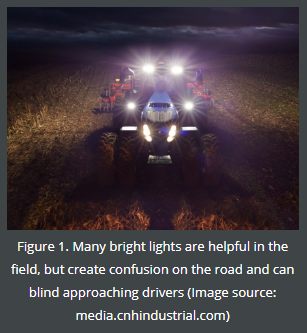
Ian McDonald, OMAFRA Crop Innovation Specialist
James Dyck, OMAFRA Engineer – Field Crop Conditioning & Environment
Jacqui Empson Laporte, OMAFRA Environmental Specialist
Terrence Sauve, OMAFRA Engineer – Farmstead Optimization & Safety
Farm equipment today is larger and can travel faster than ever before. Farms have also grown bigger, spread across fields that can be many miles from home base. Farm implements are traveling further from home to reach these fields. Farm equipment shares the road with cars and trucks, driven by members of the public who are increasingly less connected to farms. Drivers approaching a farm vehicle on the road may never have seen a tractor or farm implement before, let alone driven on the same road.
The movement of farm vehicles on public roads is one of those issues where the old standards remain in place, but the situation has changed. Farmers like to complain about “impatient urban drivers”, but the agricultural industry needs to recognize the safety risks of road travel. Larger, faster equipment traveling longer distances, often at night or in bad weather, creates significant risks for the equipment operator, and other drivers on the road.
Lights allow us to see and be seen at night and in bad weather. Modern LED and HID technology mean that night lighting can be incredibly bright. As equipment size has increased, so have the number of lights as well as the operating modes. Field lights provide incredible night vision in the field, but can be blinding on the road to approaching vehicles. A few simple steps can improve lighting safety on the road.
When turning, many modern tractors override the four-way flashers and “hold” the opposite light on – for example, in a left turn, the left signal flashes while the right signal stays lit. Does your tractor operate this way? Does equipment connected to the tractor also operate this way? If not, talk to your equipment supplier to find out how to modify the lighting to communicate turns clearly.

You may know how large and long your equipment is, but other drivers don’t. Proper lighting helps other drivers understand what they are approaching, and warns them of the hazard. And although farm implements are exempt from height, width, length and weight restrictions, the Highway Traffic Act requires you to yield a full one half of the road width. Approaching drivers expect their lane to be clear. No matter how big or wide your equipment is, you must yield half the ROAD (not half a lane) to oncoming or overtaking traffic. This applies on straight roads AND when approaching curves, bridges, hills, etc. when your view ahead is restricted.
Don’t use too many lights on the road. On the road, only 4 forward-facing headlights can be used at once. Yet some equipment may use up to a dozen field lights. Many bright lights create confusion for approaching drivers, and make it very hard to see the true width of the farm vehicle. Rear facing field lighting can blind vehicles approaching from behind, preventing them from seeing oncoming traffic. This could lead to head-on collisions.
Use the correct lighting mode for road travel. Tractors and farm implements come equipped with a wide range of light types for different purposes, including working, driving and cautioning others to the fact that you are different. Road travel mode uses the correct lights to warn approaching drivers about your equipment. More lights are not always better! Too many lights create confusion, especially for drivers unfamiliar with farm equipment.
Finally, make sure lighting is clear and working properly. Many newer tractors are equipped with rotating beacons. They also have turn signals built into the cab, fenders or installed on extensions over the tires. Wide equipment may also have flashing lights on either side to highlight its dimensions. But when the tractor driver signals a turn, it can be hard to tell which lights are the turn signals. Too many flashing lights with no clear turn signal can be very confusing to other drivers.
No one wants to be involved in an accident. Everyone has a responsibility to drive safely. And the agricultural industry can step up to show professionalism by using correct lighting and operating equipment appropriately.
When it comes to lighting on the road, don’t light more – light right.